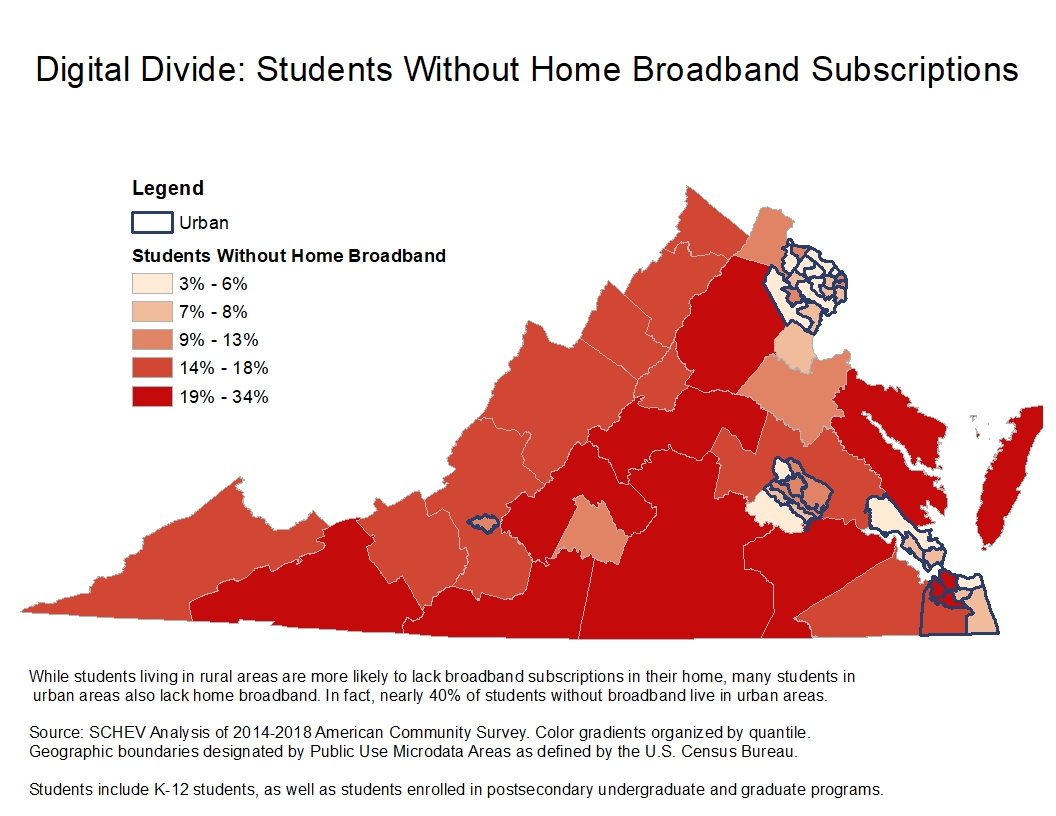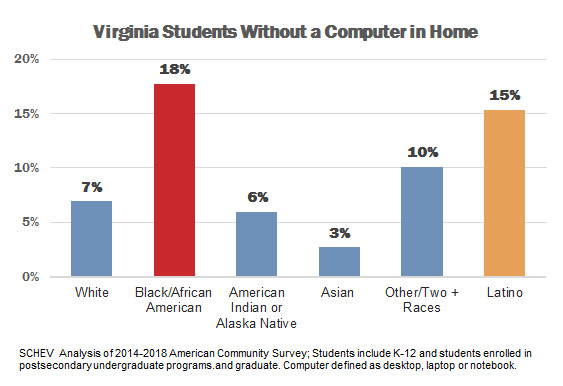Originally posted 8/4/20
There’s a lot we still don’t know about what school will look like in the fall, but one thing we do know, is that because of COVID-19, much more of it will be conducted and experienced online. Virginia may not be ready, as one in five students face technology barriers to success. The digital divide -- the disparate access to, affordability of, and use of both high-speed internet and computers -- threatens to expand already existing inequities in education.
Students without computers or reliable broadband access will be challenged to excel in or complete their studies. This post analyzes broadband subscriptions and device ownership of Virginia students based on data from the U.S. Census’ American Community Survey, and while the findings point to looming challenges for too many K-12 and higher education students in the Commonwealth, they also bring specificity to the conversation around solutions, to which the pandemic has given new urgency.
Some highlights:
- Statewide, fully one in five Virginia students (K-12 and college) lack either high-speed internet or a computer in the home, both of which are necessary for successful distance learning.
- Students living in rural areas are less likely to have broadband internet in the home compared to urban students. However, nearly 40% of all students without broadband live in or around Virginia's cities. Half of all students without devices live in urban areas.
-
Students in parts of Norfolk and Suffolk lack home broadband at higher rates than students in rural areas around Franklin, Henry, Patrick and Pittsylvania Counties.
- Black and Latinx students are twice as likely as white students not to have a computer in the home, even though these groups have broadband subscriptions at similar rates as white students.
- State policy is shifting to recognize the complexity of the digital divide, but there is still much work to be done.
The COVID-19 Education Response and Recovery Work Group recently framed the digital divide into three parts: access, affordability and skills. Obviously you can’t have high-speed internet if it is not offered in your area, so marketplace access is an important piece of the digital divide puzzle. Wireless data plans might help some students without broadband, but caps on bandwidth and fees make wireless service an imperfect substitute. This connection also needs to be affordable or subsidized. A household might also have a dozen companies to choose from, but won’t have access if they can’t afford them.
And finally, a broadband connection doesn’t matter unless you own the proper device; students with home broadband still need computers to complete their studies even if they have broadband subscriptions. We didn’t include smartphone ownership in our definition of “computer,” because they’re not comparable in terms of capability. Students who only have access to a smartphone are less likely to complete their homework, conduct research, write papers and email their teachers. A recent report from Commonsense Media and Boston Consulting Group also emphasized the importance of students having both broadband connections and adequate devices for adequate distance learning.
According to our analysis, more than 200,000 K-12 students (14%) and more than 60,000 college students (10%) in Virginia lack broadband subscriptions in the home. And 173,000 K-12 students (12%) and nearly 23,000 college students (4%) don’t have a computer in the home.
Logically, one doesn’t work without the other, so when measuring students who lack either one or both, we find that nearly one in five Virginia students lack the necessary resources to succeed in distance learning.

Virginia students’ broadband access is similar to the national rate of 13% of students lacking high-speed internet service. Regarding devices, Virginia students are in slightly better shape than the 13% of students nationwide who lack a computer in the home.
Geography
What might surprise policymakers is that the digital divide in education does not always run along rural and urban lines. For instance, students in parts of Norfolk and Suffolk lack home broadband at higher rates than students in Franklin, Henry, Patrick and Pittsylvania Counties in the Commonwealth’s Southside (West Piedmont Planning District).

Statewide, students living in rural areas are much less likely to have broadband internet in the home compared to urban students. Nearly 20% of rural students lack broadband in the home, compared to less than 10% for students living in urban areas. (The device ownership gap is less significant.) However, students in urban areas lack broadband connections too. For instance, 25% of students in Portsmouth and Norfolk lack broadband in the home. That’s higher than students in rural areas around Franklin, Henry, Patrick and Pittsylvania Counties. These students in Portsmouth and Norfolk also are least likely to have a computer in the home than anywhere else in the Commonwealth (23%).
The area around Fluvanna and Louisa Counties and the area around Bedford, Amherst and Appomattox Counties lack connectivity at the highest rates (34% and 31% respectively). Students in Fairfax and Loudoun Counties are much more connected, with only 3% of students living in households without broadband.

Given the density of urban areas, nearly 40% of all students without broadband live in or around Virginia's cities. Moreover, of all the students without devices in the home, half live in urban areas. This shows the difference between broadband access (whether there are companies that provide broadband subscriptions for your home) and adoption (whether you can afford that subscription, and if you actually pay for it).
Race and Ethnicity
While there aren’t significant gaps in broadband subscriptions by race and ethnicity, there are gaps by device ownership. Black and Latino student households each are more than two times likely to lack a computer or laptop in the home than white students. This raises significant concerns that Latino and Black students, who already lag behind their white and Asian peers in education attainment, will struggle to keep pace in a virtual learning environment this fall.

Income
Not surprisingly, the digital divide runs starkly along income as well. About 16% of low-income student households (defined as income falling below 200% of the federal poverty level) lack internet in the home, compared to 13% for middle-income and 8% of high-income student households. For devices, 19% of low-income student households don’t have a computer, compared to 7% for middle-income and just 2% for low-income households.
Solutions
Commonwealth Connect, the flagship broadband initiative in Virginia, has set a goal of universal broadband access. A major component of that initiative is the Virginia Telecommunication Initiative (VATI), administered by the Department of Housing and Community Development. Between VATI and the Tobacco Region Revitalization Commission, the Commonwealth has deployed $44 million leading to the connection of over 108,000 homes and businesses since 2017. While primarily focused on rural infrastructure, the evaluation criteria for each grant application includes points for applications that include plans to increase adoption and digital literacy. The 2021-22 state budget included $32 million in additional VATI support for the 2021-22 biennium. Unfortunately, due to the crisis brought on by the COVID-19 pandemic, Governor Northam was forced to unallot that funding in April 2020.
Governor Northam’s COVID-19 Education Work Group, made up of education stakeholders from across the Commonwealth and tasked with helping schools reopen safely and equitably, are exploring how to address the digital divide in education. This group recognized the multi-faceted nature of the problem that includes barriers to access, affordability and use, and included recommendations for funding for adequate technology and technical support resources for students, as well as subsidizing subscriptions and training.
The Governor's Emergency Education Relief Funds (GEERF), a portion of the CARES funds, also emphasized technology. In higher ed, the majority of funds went to student aid, with the flexibility that they could be used for technology stipends. The Virginia Community College System also received support for broadband projects, such as extending wifi to their parking garages to allow for social distancing. UVA-Wise was already a leader in this area, distributing iPads to all students, faculty and staff.
Finally, every community in America has faced a more urgent remote learning landscape since the onset of COVID-19 earlier this year, and there will be innovative and proven solutions from which every state can learn. A Kansas startup, for instance, is turning school buses into rolling WiFi hotspots, each of which can power a residential block or apartment building. Financial aid expert and philanthropist Abigail Seldin recommends institutions incorporate technology costs into their cost of attendance, thus raising the maximum eligibility for aid.
Takeaways
Students in every community in the Commonwealth face challenges related to the digital divide. And while the roadblocks have the same impact on students, they may require different policy solutions. For example, students in Fluvanna or Louisa County are more likely to need assistance with broadband access, while students in Portsmouth and Norfolk may need additional help with device affordability.
Like many other issues, COVID-19 has highlighted the inequities our students face in digital learning. However, it also presents an opportunity to form a comprehensive response to the challenges presented by the digital divide. We hope this post sheds light on the different ways this divide impacts our students and how policymakers can begin to address it.
*Methodology
Data for our analysis comes from the American Community Survey (ACS), a national survey conducted annually by the U.S. Census Bureau. SCHEV staff sourced the data from IPUMS USA, a project of the University of Minnesota. We used five years (2014 - 2018) of data, all collected before the pandemic, to push the sample size up to 15 million Americans nationwide, and approximately 420,000 in Virginia. All estimates produced p - values ≤ 0.02. For states or researchers interested in replicating the analysis, the authors can provide code in STATA or R upon request. All tables used in this analysis can be accessed here.
The ACS defines broadband (high speed) Internet as having cable, fiber optic or DSL service; we categorized individuals as having broadband if their household reported subscribing to at least one of these services. We similarly defined individuals as having computer access if their household owned or used a desktop, laptop, netbook or notebook computer.
To map broadband and computer access, staff used the ACS’s method of categorizing individual’s geographic location. The U.S. Census Bureau standardizes geographic areas called Public Use Micro Data Areas (PUMAs), which have roughly the same amount of people in them. Although this makes them a useful way to compare by standardized geographic units, the downside is they’re not as easily recognizable as city or county names. The ACS also doesn’t organize PUMAs by urban and rural. These designations were made by SCHEV staff, but we have included a layer on the map, as well as included how each PUMA was designated in the tables.
Digital Divide FINAL | Digital Divide DataTables [xls]
Welcome to Insights, SCHEV's platform to interpret and communicate data and policy with the overall goal of informing policy-making, engaging institutions and drawing attention to these resources. Centered around SCHEV's nationally leading data collection, each Insight will visualize complex ideas and help inform funding and policy decisions.
